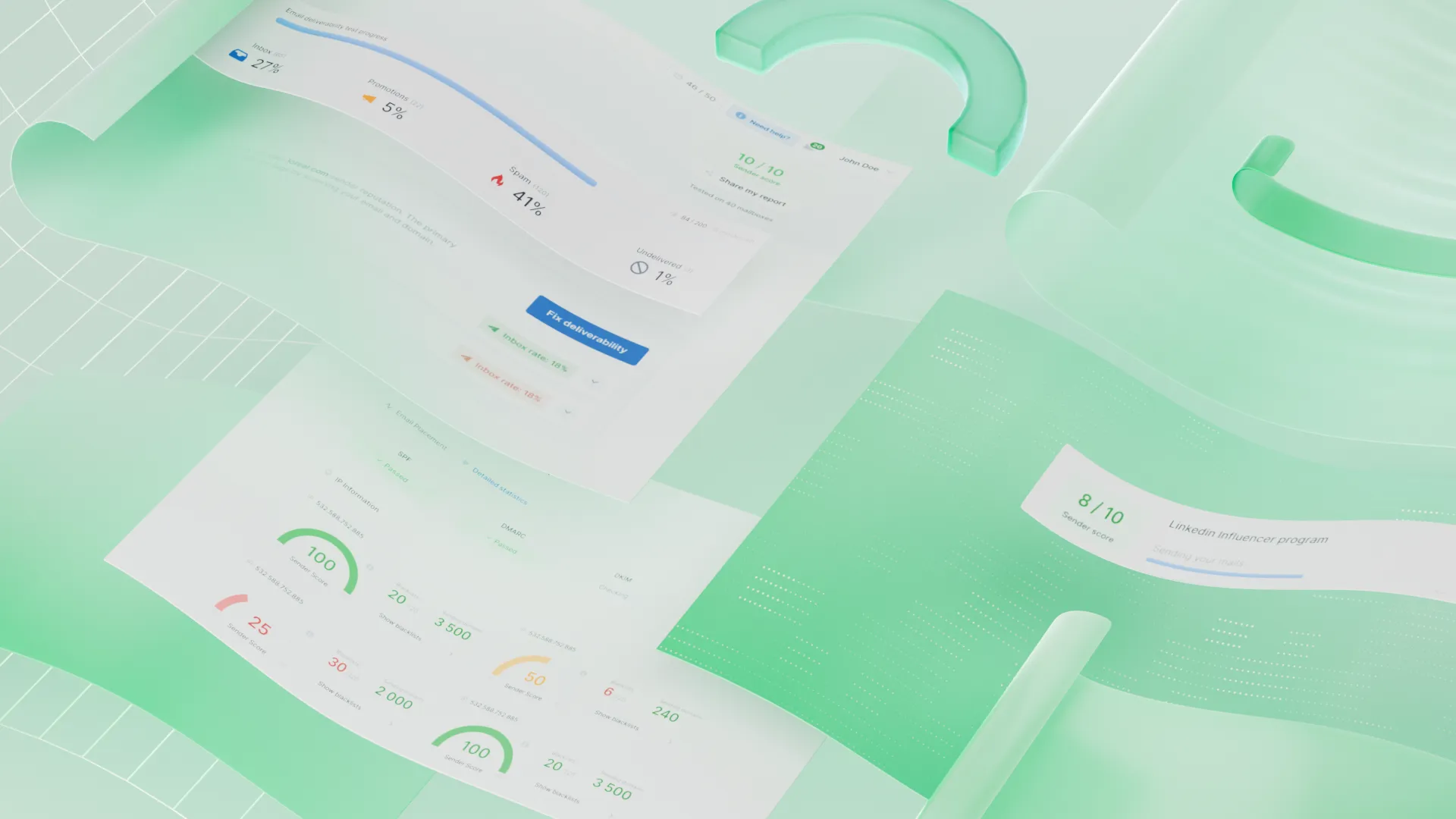To run marathons and work out properly, you need a healthy body. To keep your email campaigns reaching your intended recipients, you need a healthy domain. Sounds simple enough. However, just like keeping your body healthy means keeping your eye on a lot of things (your hydration levels, how much nutrients you're getting, the state of your joints, etc.), domain health requires taking an entire plethora of factors into account.
Good thing that, unlike with personal health, you don’t have to spend hours on doctor appointments and blood tests. You can figure out your domain health and ways of improving it with a single click.
But let’s not get ahead of ourselves.
What is domain health made of?
Domain health is another word for domain reputation because if any domain has a low or negative reputation, it ceases to exist. Email service providers and internet service providers do their best to remove a low-reputation domain from participating in a day-to-day email exchange, resulting in the compromised domain essentially becoming dead to the world. That's why senders are encouraged to take interest in what's going on behind the curtains of their email outreach and at the very foundation of their email marketing a.k.a their newly registered business domain.
At the very beginning, your domain has a neutral reputation - good enough to get started, not good enough to launch the massive email marketing campaigns you want. It's just like coming to the gym the first time - your body is healthy enough to handle basic strength exercises, but if you skip those and go straight to professional powerlifting, it won't end well for you. You will get there, eventually, with enough motivation, a proper diet, and a steady exercising schedule - as well as the full knowledge of your strongest and weakest aspects.
What are the most important parts of your domain health?
- DNS records. That part includes your three most important email authentication protocols (an SPF record, a DKIM signature) as well as your MX record (see the guide to setup MX records), A record, and all DNS settings responsible for properly transferring email between your servers and your recipients' servers.
- Blacklist. When your domain name ends up on a black list, this is a serious symptom indicating that you have problems with spam filters and email service providers consider you a threat. You are added to blacklists based on your IP reputation, which takes into account your sending behavior (if you're inclined towards malicious sending activity, you increase your chances of landing on a blacklist). This is why it's always better to get a dedicated IP address instead of a shared one - because in the latter case, you will be sharing a reputation with other senders who break email-sending guidelines. You are never alerted when you get blacklisted, so scanning blacklists in advance is a good measure.
- Simple Mail Transfer Protocol (SMTP). This protocol is responsible for your email exchange. It contains a set of commands that directs and authenticates email transfer. To perform correctly, SMTP needs an SMTP server, which is present in every email client and sends emails to your intended recipients. Once you hit "Send", your email becomes a string of code that is then sent to your SMTP server that processes it and sends it to receiving servers. After those servers authenticate your message, they allow it to get displayed in recipients' inboxes. Therefore, if your SMTP server doesn't read the code properly, you get a delivery failure and your messages don't go anywhere.
- Sending policy. Sending policy or DMARC policy is a record that helps senders protect their domain name from being abused by spoofing. This record builds from your DKIM signature and SPF record, instructing receiving servers on what to do with emails that allegedly come from you but fail authentication checks. For example, you configure your DMARC policy to reject all emails that fail authentication checks and send you a notification whenever it happens - that keeps harmful emails from getting to your recipients and instantly alerts you that someone has been trying to spoof your domain name, letting you take measures.
Great news! We have a free DMARC generator where you can create a valid record for your domain in a few clicks.
These components of your domain health require regular checkups to make sure they can keep up with your email marketing plans. They are also the ones you should go over immediately as soon as you see a drop in your performance and inbox placement rate.
How to check your domain health?
It's hard to do so manually - you would either need assistance from your domain's host team or a wide asset of tools for checking your blacklists, your DNS records, your SMTP protocol, etc. The good thing is, that some of these tools are free. The bad thing is, that you will need a lot of tabs to keep all of these tools at hand - and you will have to manually enter your domain name for each tool over and over again. That's a good way to grow insanely tired of the much necessary routine.
Another issue with such tools is that even though they point out your domain health issue, they don't provide a solution. Let's say, your SPF record generator reveals that your SPF record exceeds the number of lookups. What does it even mean? You don't know, so you spend a while in Google, trying to understand the problem and how do you solve it. And let's not even mention more complex issues. That's the general problem with available DNS record checkers - they are designed for users who are well aware of the complexity of domain health and DNS settings, so they already know how to fix issues, they only need a push in the right direction.
However, when you are a beginning sender who is still making sense of mechanisms and modifiers behind an SPF record, you need a more specific tool that would provide you with an explanation and outline a solution to you.
How can Folderly Email Deliverability Test help you?
Folderly Email Deliverability Test is a feature that was designed specifically for users who aren’t familiar with domain components and need tips and instructions in addition to a simple domain health audit.
Folderly Email Deliverability Test provides full-scope research of your domain, going through its entire structure and providing you with information about the following:
- WHOIS. Folderly Domain Health Test does a WHOIS lookup and scans through your WHOIS records to make sure that neither your domain name nor your email addresses or your shared IP addresses are used by cybercriminals and phishers. This way, you will always know whether your domain and sender image is safe or compromised.
- IP overview. The test overviews the activity of your IP address and shows you how internet service providers see you. It's a good feature for monitoring the behavior of the users that share your IP address (in case you're using a shared one) or evaluating the overall state of your dedicated IP address.
- Protocols. Folderly Email Deliverability Test checks how your IMAP vs SMTP servers process your emails and informs you of any technical issues that obstruct your email delivery.
- DNS records. Folderly Test goes through every DNS record, making sure that your SPF record, your DKIM signature, your BIMI record as well as MX record and A record are generated correctly and function as intended. The analysis comes complete with explanations regarding the issue encountered.
- Blacklists. Folderly combs through all major blacklist databases. If it comes across your domain name, it will inform you about it in the report.
All that information is structured in a dashboard, letting you get a full picture of your domain’s state and understand what’s affecting your domain health.
Additionally, Folderly Email Deliverability Test provides users with unique benefits such as:
- Visible Sender Score. Sender Score is an estimate of your current domain reputation. A high Sender Score means that you're doing great, observe all email-sending guidelines and no issues or setbacks are affecting your deliverability. A medium Sender Score shows that there is still work to do, while a low Sender Score signifies that your domain health needs fixing. As a rule, senders don't know their Sender Scores - this information is available to internet service providers only. However, advanced tools like Folderly can provide you with an average rating, giving you an idea of where are you right now and what you should do to move forwards.
- Detailed summary. You aren't left in the dark with all the data provided to you by Folderly. You also receive a report that gives you an in-depth description of your domain's performance and introduces you to both good and bad news. It explains where your domain issues came from and how they affect your deliverability.
- Customized tips. This part of Folderly Email Deliverability Test is brought to users by the team who personally analyzes your domain health, and your email marketing goals and comes up with a set of instructions on how you can improve your condition, what measures you should take to get rid of the issues and how to avoid those issues in the future.
The goal of Folderly Email Deliverability Test is to make sure you truly understand what is going on with your domain, how to influence its health, and how you can truly succeed with your campaigns.
How often should you run an email deliverability test?
If your Sender Score is high and your email delivery is going smoothly, you only need to check up on your domain every three weeks.
However, if you have suspicions about your performance slowing down and start receiving complaints from your subscribers, you should run a domain health test at once - and keep checking it every two weeks to see how well you’re doing at fixing your sudden deliverability issues.
In general, we recommend getting a reliable tool for monitoring your progress and instantly notifying you about the budding problems before you start rolling your email campaigns. When you know the inner workings of your domain and understand how to make them tick, managing your email marketing activities will become a lot more fun.

